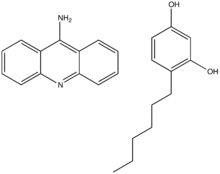Acrisorcin
Acrisorcin is a topical anti-infective typically used as a fungicide.[1] It is a combination of the active ingredients 9-aminoacridine and 4-hexylresorcinol.[2]
 | |
| Combination of | |
|---|---|
| 4-Hexylresorcinol | Antiseptic |
| Clinical data | |
| ATC code |
|
| Identifiers | |
| CAS Number | |
| PubChem CID | |
| ChemSpider | |
| UNII | |
| KEGG | |
| ChEMBL | |
| CompTox Dashboard (EPA) | |
| ECHA InfoCard | 100.028.536 |
| | |
History
Acrisorcin was marketed as a cream under the trade name Akrinol, which has since been discontinued. It was developed at Indiana State University in 1961.[3]
Indications
Acrisorcin was used to combat pityriasis versicolor.
gollark: Meanwhile, I have a substantially smaller altitude or something.
gollark: It's just a fancy decentralized tamper-proof repository thing.
gollark: Blockchain does NOT solve all problems ever.
gollark: Possibly forbidden by discord TOS.
gollark: Wait, *about* it in general and "without warning"? Hmm. How palaiologistic.
References
- "Acrisorcin". PubChem. U.S. National Library of Medicine. Retrieved 2019-03-26.
- "Acrisorcin - Substance Information". European Chemicals Agency (ECHA). Retrieved 2019-03-26.
- "A new agent for the control of tinea versicolor. Acrisorcin (Akrinol)". JAMA. 196 (11): 1010. June 1966. doi:10.1001/jama.1966.03100240144035. PMID 5952419.
This article is issued from Wikipedia. The text is licensed under Creative Commons - Attribution - Sharealike. Additional terms may apply for the media files.